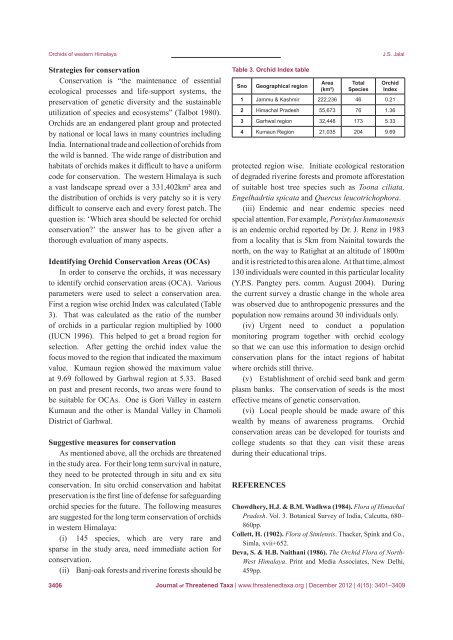December 2012 - Journal of Threatened Taxa
December 2012 - Journal of Threatened Taxa
December 2012 - Journal of Threatened Taxa
Create successful ePaper yourself
Turn your PDF publications into a flip-book with our unique Google optimized e-Paper software.
Orchids <strong>of</strong> western Himalaya<br />
Strategies for conservation<br />
Conservation is “the maintenance <strong>of</strong> essential<br />
ecological processes and life-support systems, the<br />
preservation <strong>of</strong> genetic diversity and the sustainable<br />
utilization <strong>of</strong> species and ecosystems” (Talbot 1980).<br />
Orchids are an endangered plant group and protected<br />
by national or local laws in many countries including<br />
India. International trade and collection <strong>of</strong> orchids from<br />
the wild is banned. The wide range <strong>of</strong> distribution and<br />
habitats <strong>of</strong> orchids makes it difficult to have a uniform<br />
code for conservation. The western Himalaya is such<br />
a vast landscape spread over a 331,402km² area and<br />
the distribution <strong>of</strong> orchids is very patchy so it is very<br />
difficult to conserve each and every forest patch. The<br />
question is: ‘Which area should be selected for orchid<br />
conservation?’ the answer has to be given after a<br />
thorough evaluation <strong>of</strong> many aspects.<br />
Identifying Orchid Conservation Areas (OCAs)<br />
In order to conserve the orchids, it was necessary<br />
to identify orchid conservation areas (OCA). Various<br />
parameters were used to select a conservation area.<br />
First a region wise orchid Index was calculated (Table<br />
3). That was calculated as the ratio <strong>of</strong> the number<br />
<strong>of</strong> orchids in a particular region multiplied by 1000<br />
(IUCN 1996). This helped to get a broad region for<br />
selection. After getting the orchid index value the<br />
focus moved to the region that indicated the maximum<br />
value. Kumaun region showed the maximum value<br />
at 9.69 followed by Garhwal region at 5.33. Based<br />
on past and present records, two areas were found to<br />
be suitable for OCAs. One is Gori Valley in eastern<br />
Kumaun and the other is Mandal Valley in Chamoli<br />
District <strong>of</strong> Garhwal.<br />
Suggestive measures for conservation<br />
As mentioned above, all the orchids are threatened<br />
in the study area. For their long term survival in nature,<br />
they need to be protected through in situ and ex situ<br />
conservation. In situ orchid conservation and habitat<br />
preservation is the first line <strong>of</strong> defense for safeguarding<br />
orchid species for the future. The following measures<br />
are suggested for the long term conservation <strong>of</strong> orchids<br />
in western Himalaya:<br />
(i) 145 species, which are very rare and<br />
sparse in the study area, need immediate action for<br />
conservation.<br />
(ii) Banj-oak forests and riverine forests should be<br />
Table 3. Orchid Index table<br />
Sno<br />
Geographical region<br />
J.S. Jalal<br />
protected region wise. Initiate ecological restoration<br />
<strong>of</strong> degraded riverine forests and promote afforestation<br />
<strong>of</strong> suitable host tree species such as Toona ciliata,<br />
Engelhadrtia spicata and Quercus leucotrichophora.<br />
(iii) Endemic and near endemic species need<br />
special attention. For example, Peristylus kumaonensis<br />
is an endemic orchid reported by Dr. J. Renz in 1983<br />
from a locality that is 5km from Nainital towards the<br />
north, on the way to Ratighat at an altitude <strong>of</strong> 1800m<br />
and it is restricted to this area alone. At that time, almost<br />
130 individuals were counted in this particular locality<br />
(Y.P.S. Pangtey pers. comm. August 2004). During<br />
the current survey a drastic change in the whole area<br />
was observed due to anthropogenic pressures and the<br />
population now remains around 30 individuals only.<br />
(iv) Urgent need to conduct a population<br />
monitoring program together with orchid ecology<br />
so that we can use this information to design orchid<br />
conservation plans for the intact regions <strong>of</strong> habitat<br />
where orchids still thrive.<br />
(v) Establishment <strong>of</strong> orchid seed bank and germ<br />
plasm banks. The conservation <strong>of</strong> seeds is the most<br />
effective means <strong>of</strong> genetic conservation.<br />
(vi) Local people should be made aware <strong>of</strong> this<br />
wealth by means <strong>of</strong> awareness programs. Orchid<br />
conservation areas can be developed for tourists and<br />
college students so that they can visit these areas<br />
during their educational trips.<br />
References<br />
Area<br />
(km²)<br />
Total<br />
Species<br />
Orchid<br />
Index<br />
1 Jammu & Kashmir 222,236 46 0.21<br />
2 Himachal Pradesh 55,673 76 1.36<br />
3 Garhwal region 32,448 173 5.33<br />
4 Kumaun Region 21,035 204 9.69<br />
Chowdhery, H.J. & B.M. Wadhwa (1984). Flora <strong>of</strong> Himachal<br />
Pradesh. Vol. 3. Botanical Survey <strong>of</strong> India, Calcutta, 680–<br />
860pp.<br />
Collett, H. (1902). Flora <strong>of</strong> Simlensis. Thacker, Spink and Co.,<br />
Simla, xvii+652.<br />
Deva, S. & H.B. Naithani (1986). The Orchid Flora <strong>of</strong> North-<br />
West Himalaya. Print and Media Associates, New Delhi,<br />
459pp.<br />
3406<br />
<strong>Journal</strong> <strong>of</strong> <strong>Threatened</strong> <strong>Taxa</strong> | www.threatenedtaxa.org | <strong>December</strong> <strong>2012</strong> | 4(15): 3401–3409

















